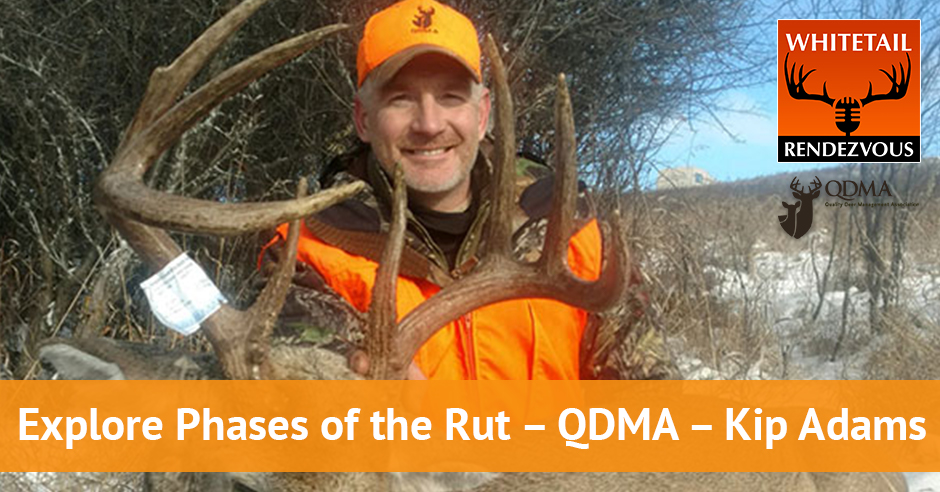
As seasons change, the behavior of deer changes with it. Kip Adams talks about the phases of the rut and the hormonal changes some animals, specifically deer, go through during September when there is lower amount of daylight. It has been observed that during this season, most deer have some rub lines and scrapes. Kip is a certified wildlife biologist and QDMA’s Director of Conservation. He discusses the perfect timing for hitting the scrapes, as well as rattling, tending grunts, and how to understand what the deer are communicating about. He also points out how a hunter’s understanding of the annual movement pattern of deer is beneficial.
—
listen to the podcast here:
Explore Phases Of The Rut – QDMA – Kip Adams
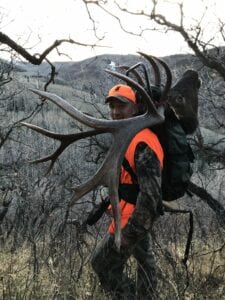 I’m with Kip Adams. He’s the Director of Conservation at QDMA, Quality Deer Management Association. Kip, welcome to the show.
I’m with Kip Adams. He’s the Director of Conservation at QDMA, Quality Deer Management Association. Kip, welcome to the show.
Good to see you, Bruce. Thanks for having me on.
It’s been a while since you have been a guest. I wanted to talk about the rut. Somebody said the other day, “Blue Moon was October 24th, the rut started.” I go, “Maybe that’s not quite true.” As we talked about in the warm-up, to me the rut starts when the bucks’ horns hardened in August. All of a sudden, they’re adults now. They know something’s changing in their body. Testosterone is running through their body and things have changed. Let’s start right there. What’s happening to the bucks in September? What’s it all leading up to?
Rubs are great ways for bucks and does to communicate with others in the area. Share on XThe big change is we’re getting lower amounts of daylight each day. That photoperiod is changing as we start to get to the end of the summer and into fall. Deer take that. With that change in photoperiod means is that you get a hormone change in your body. You get a big spike in testosterone. That’s what’s required for bucks to harden their antlers and shed that velvet off. Those buddies, they’ve been together oftentimes since winter until January. They spend all winter, spring, and summer together because testosterone levels were low. All of a sudden, they’re not low anymore and these bucks don’t like each other.
Antlers are hardened, velvet sheds off, and pressure starts to increase. Every line is a kickoff to all that fun stuff that we want during the fall. Those bucks start to break up a little bit and they start sparing. That’s developing a pecking order, just like dogs, chickens, and everything else. They have a very well-defined pecking order. When they get into the full-blown rut, they can hurt themselves fighting. They can die fighting. If they don’t have to do that, they won’t. They spend a lot of time developing that pecking order prior to the rut to help eliminate some of those fights once things get fast and furious.
One thing I’ve heard and seen myself is that all of a sudden, you’ll start seeing some rub lines, some football-size scrapes. Why does that happen in September?
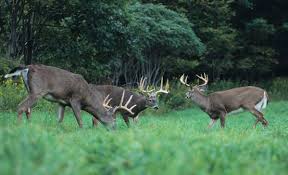 Deer are very social animals. A lot more social than many people realize. The best two ways for them to communicate are through rubs and scrapes. We’ll start with rub. People used to think that that’s just the way for deer to get of that velvet off their antlers. It’s a lot more than that. Buck has seven glands on their body. The most important is the tarsal gland between their behind legs, but the second most important is the forehead gland. Researchers from the University of Georgia have identified nearly 50 different pieces of information that bucks can convey about themselves through that forehead gland. A lot of that rubbing that we see, they use that some to get that velvet off, but when the bucks rub, what are they doing?
Deer are very social animals. A lot more social than many people realize. The best two ways for them to communicate are through rubs and scrapes. We’ll start with rub. People used to think that that’s just the way for deer to get of that velvet off their antlers. It’s a lot more than that. Buck has seven glands on their body. The most important is the tarsal gland between their behind legs, but the second most important is the forehead gland. Researchers from the University of Georgia have identified nearly 50 different pieces of information that bucks can convey about themselves through that forehead gland. A lot of that rubbing that we see, they use that some to get that velvet off, but when the bucks rub, what are they doing?
They rub their antlers, but they also rubbed their forehead on that rub. Often, they bite the cambium layers of the tree, get the bark off it and rub their forehead on it. They are leaving their calling card there so other deer can then come in and receive information about that buck. Oftentimes, their age, their nutritional status, their dominant status, how long ago they were in the area. Rubs are a great way for bucks and does to communicate with others in an area, which is pretty cool. It’s their version of their cell phone. That is one of the ways they communicate.
Is that called the preorbital gland?
The preorbital gland is right on the corner of their eye, the forehead gland is right on their forehead. If you look at older bucks during the rut, that forehead gland often changes color because of all the increased glandular activity. It often will change color. Sometimes they will get wavy. If you look it up, particularly the older bucks, often you’ll get some little red in there or a little darker. Albino deer are great examples. Albino deer are all white, but they will turn brown in two places during the rut, their tarsal glands and their forehead glands. After the rut that forehead gland will go back to being white once all that increased activity stop. The forehead glands are a cool thing that not a lot of hunters know about.
They’re leaving their scent. They’re marking their territories, like a cat or a dog marking their territory, and leaving information about themselves for everybody else to check them out. When they open up these small scrapes, what’s that doing?
That’s another way to communicate. Rather than using their forehead gland, they’re using their tarsal gland for this ability to scrape. Often, there’s existing scrape, they often still will fall in the dirt a little bit and that as much as anything attracts to. You can go to an area that’s in the woods covered with leaves or an area in the yard that’s covered with grass. You make a big open spot of dirt, do nothing else that will attract deer. Deer see that open spot of dirt and they almost can’t go to it. They have to go and check it out because they know that’s how they communicate. In a scrape, you have that open spot of dirt and the most important part of the scrape often is the licking branch, which is just above the scrape. If you watch, they will grab that. They will mouth it and smell it. They will rub their preorbital gland often on that licking branch.
Sometimes they will rub their forehead gland on it, which was not just an indiscriminate mark. It’s a very purposeful mark. They will smell it, work it, smell it and work it until they get the right scent on that. They will leave the scent on the branch above the scrape. If you have a hot scrape and you remove that licking branch, you’ll stop the activity there. Licking branch is that important. Bucks have to have that licking branch to go through the whole ritual with the scrape. If your buck is being mean and he knocks that branch down, you can take a branch there and just hang it back. Either put it on the ground that goes over it or hangs it from a tree. Bucks don’t care how it is. They need something there to be able to work.
They’ll work that licking branch and, in the scrape, they smell who has been there through their urine. That’s how deer can tell each other as well. They oftentimes will rub-urinate, which is they will urinate into the scrape to leave their own scent. Rub urinate means they rub their hind legs together while they’re urinating over those tarsal glands. The tarsal gland is the most important gland on deer’s body. Unlike the forehead gland, there’s no glandular activity inside the body. Tarsal glands are specialized hairs that capture the urine and holds some of the particles of that. That’s what gives you that musky smell. Their unique smell during the rut. That’s their calling card where other deer know who they are and they can communicate things about themselves like in a rub in a different way.
We know that bucks to do this year-round. It’s not during the rut. Bucks will scrape twelve months a year, but they tend to do a lot more during the breeding season. Does will scrape all year long and even fawns will scrape. Fawns will rub urinate. They’re putting their scent on themselves. All that happens throughout the year, which is one of the ways that deer are being social and communicating with others, but it all ramps up during the rut. That’s when it comes to a peak when we can put cameras on those trees and get pictures of all kinds of different deer. We monitor what’s going on in the deer.
There are not many people who would pass the four-year-old buck. Share on XLet’s talk about this time phase of the breeding season. Scrapes are opening up. Licking branches, they’re utilizing them. Rubs are opening up. How do I hunt that? What’s the best setup? Do I set up on a scrape or on food sources? Where do I need to be?
There’s a lot of hunters that have spent a lot of times sitting over scraped and not seeing anything. That’s because research shows about 84% of all scrape use occurs at night. The vast majority of times, bucks and does are checking those scrapes during the dark when we can’t hunt on deer. It doesn’t mean that you can’t kill deer there because somewhere around 16% of those visits are during the day. There are a lot of hunters that sat over the scrape and killed deer. What is more effective though is to understand that they hit most just before daylight in the morning and oftentimes just after dark.
If you know where your deer is bedding during the day or where it wants to go feed, you know he is going to be hitting these scrapes right at dark or dawn or dusk. You can still use that information to position yourself. Maybe you know a buck wants to go into a certain scrape. He’s going to arrive there just after dark. If you know where he’s bedding during the day, you can position yourself between that bedding and scrape to intercept him during shooting hours. Even though they’re not the most productive places to set over, you still can use their locations to your benefit or to your knowledge. It will still help you kill a deer that wants to get to that scrape mark.
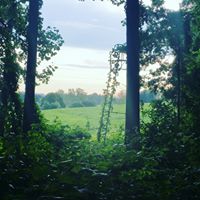 That’s one thing about knowing the terrain, pinch points, and funnels. I can think of one of my favorite places to sit in Buffalo County. It’s a funnel. It’s a river bottom. It’s got everything a guy could want. The way we’d set up is between the bedding area and the feeding area. We know they’re going to hit that scrape before they go to feed. The food is away from there. They’re going to hit that maybe twenty minutes of light left. You don’t need these seconds for him to come in and do his thing. You’re sitting there at legal light and the deal is over.
That’s one thing about knowing the terrain, pinch points, and funnels. I can think of one of my favorite places to sit in Buffalo County. It’s a funnel. It’s a river bottom. It’s got everything a guy could want. The way we’d set up is between the bedding area and the feeding area. We know they’re going to hit that scrape before they go to feed. The food is away from there. They’re going to hit that maybe twenty minutes of light left. You don’t need these seconds for him to come in and do his thing. You’re sitting there at legal light and the deal is over.
You have to know your grounding. You have to know everything about that deer. That’s why whitetail hunting is amazing because every year you learn something new. You and I have been out for a long time and every year we get schooled. Every year we learn something new and another piece of information. QDMA is probably the best repository of pure whitetail research in the country. How does somebody get ahold of QDMA if they want to follow up with Kip Adams or read some of the fantastic information you do have.
We have a great website, which is QDMA.com. The purpose of that is to provide a tremendous amount of information for hunters. To teach them more about, how deer move, how deer see, how they hear, feeding patterns, how to enhance habitat. Our job is we look at it as QDMA is where hunters belong because we have this information to help them. We help them have better hunting experiences and all that. If folks want to come and grab some of that information from our website, articles, videos, etc., that’s great because we want to share that information. If they want to become a member and help to support your organization that’s fighting for deer hunters’ rights, that’s even better and we welcome that as well.
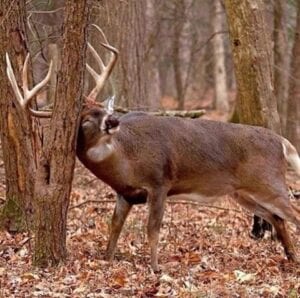 Things are starting to line up. The youngsters are acting up in the barn and doing some things. If you spend any time at all in the woods or monitor your trail cameras, you’re starting to see a little bit of daytime activity. We’re still away from the prime breeding season. What do you call the next phase of the rut?
Things are starting to line up. The youngsters are acting up in the barn and doing some things. If you spend any time at all in the woods or monitor your trail cameras, you’re starting to see a little bit of daytime activity. We’re still away from the prime breeding season. What do you call the next phase of the rut?
We know that mostly in the United States, the main part of the rut or at least when deer are being bred often occurs in that mid to early November time. Leading up to that, we get to see all kinds of breeding behaviors in the woods. Number one being scrape activities increasing. We’re seeing more and more scrapes, which is a lot of fun to watch, monitor and put a camera on. You’re seeing a lot of the young bucks on their feet chasing. For the first time, you’ll see them harassing does. We’ve been seeing here in Northern Pennsylvania a lot of harassing by those young bucks. The majority of breeding doesn’t start there. I’m sure some does have been bred though because some tend to come in earlier.
The first thing you’ll see is that increased scrape use and you start seeing a lot more yearling bucks chasing some does. You start seeing more does trying to get rid of those bucks. They are being harassed. Once you start seeing that a little bit, you know deer breeding is getting close. You’ll start seeing some of those older bucks spending more time checking those does and checking those food sources for those does. At least in Northern Pennsylvania, lots and lots of young buck activity are starting to push those a little bit. You can call it what you want, the chase phase, the seeking phase, or whatever it is. It’s more accurate to say “We’re seeing the young bucks on their feet. We know that will blend into older bucks on their feet more and right into the majority of does to breed.”
What hunting techniques or strategies should I be employing now?
If you’re looking to shoot a doe, they’re all over food sources because they know that it’s going to be hard to feed over the next couple of weeks. Food sources are a tremendous place to be able to watch does. A lot of young bucks, those older bucks, they are still hanging back. They are still in a lot of covers. I certainly would not hit my best places or have my best places back in cover yet. I personally am hunting the fringes to some of those better areas. Those older bucks still got to feed. They’re trying to put out a lot of weight as well because once they get into the rut, they may go a month of eating very little. Food sources are important to them as well. They often don’t want to be associated with all of that mess of those young bucks are running around.
The big food plots often are not the place to see the older bucks. All our food plots have been covered or where those older bucks can be by themselves and get away from that melee or often a better choice for those older bucks. It’s a great time too to be able to take a doe or two to help get some meat in your freezer. When you’re not messing up any of your buck hunting, once those older bucks start moving, you can concentrate strictly on older bucks. You’ve already got some meat in the freezer. You’ve done a good job from a deer manager taking that and handle this deer that needs to be shot if that’s the case in your area, concentrate hard on bucks once the Halloween hits.
On social media, everybody likes to put their grips and grins. It seems throughout the country, not just in Iowa or Kansas, but some big bucks are being taken in Western Kentucky. Everybody loves to see big bucks. Unfortunately, people will put in the smaller buck their first buck that they’ve taken. I see a little bit of that, but certainly not enough of that. I’ve seen a lot more doe pictures. It seems from the unscientific observation that a lot of mature deer have been taken in various parts of the country. Have you seen that trend? I know it’s unscientific, but it’s what’s popping up on social media.
If you're a deer enthusiast, you should at least care that there are older bucks because that's how deer herds evolve. Share on XWe have seen that over the last few years. As much as anything, what’s related to that is the hunter’s better understanding of the annual movement patterns of deer. For example, people often say that rut is the best time to kill a big buck. The rut is either an all or nothing thing in many cases. You can have an outstanding day and have deer all over you if you have a hot go nearby. I spend a lot of the early November days sitting in the stand and see almost nothing because all the bucks were going away a little bit with another doe. More people catch on some bruises towards the end of summer when deer are on that feed bed pattern.
If older bucks often have good food and good cover close by, they don’t move very far. Into September, early October, that often is the best time to pattern an older deer. We have hunters understanding that and taking advantage of it. Once the rut starts, it’s difficult patterning individual deer because they can be anywhere. Whereas early season, those deer haven’t been pressured yet. They haven’t been pushed yet. Testosterone levels aren’t as high yet. In a lot of cases, you have a better chance to pattern an individual deer you’ve been watching. Some of the increased in big deer early that we’re seeing online over the last few years is partly because you have more hunters understanding that and that often is a better time to have one of those big deer.
I’ve noticed a lot of velvet buck, a lot being an unscientific word. I remember talking to Josh Honeycutt, he took a 178 pointer. It was a monster of an eight pointer. It was in velvet. It was on the feed bed routine. He scouted it over. It came out. He set up his tree stand and killed it the next night. It was over. The deer was clueless. There was no pressure on him, nothing. It was his first sit ever on that buck, on that place. It’s the perfect thing. The rut is exciting. I love all-day sits. It kept me in the right place. I love being out in the woods in the fall. It’s a great thing to do. Think about some of these people that are taking these deer starting as soon as the season opens all through the fall. They’re taking mature whitetails. A mature whitetail, in my estimation, is four and a half years old.
There’s no real hard year on that thing. They often talk about young bucks being one or two years old, middle-aged is three and four, and fully mature is five and older. There’s no doubt that a four-year-old buck is mature. In many cases, people talk about three-year-old as being mature. There’s no real hard fast rule for it. Often, it’s what your personal goals are and the crowds that you run with. Certainly, there are not many people who would pass a four-year-old buck. They would look at that as a mature animal and where they have the opportunity to shoot. Nobody is going to argue with that.
One of the trends I remember reading was age class is increasing, especially I know when Wisconsin, the age class is increasing and that’s a good thing. Why is that a good thing, Kip?
In many cases, it’s nice because we have the opportunity to hunt older deer, which hunters love. For many years we over harvested young bucks and had terrible age structures through a lot of our deer. It’s very unnatural age structure. Now through QDM and our educational efforts, we have it where suddenly, we’re protecting more younger bucks, getting deer into those age classes. It’s just being a good deer manager. If you look at how hundred deer herds are, they have bucks that are one to eight-year-olds. If you look at the history of Native American Indians, their trash files, age structures of those deer were very balanced across all age classes.
Deer managers now, it’s nice that we can have deer in all those age classes. What I tell people, even if you’re not a big buck hunter, if you’re a deer enthusiast, you should at least care that there are older bucks there because that’s how deer herds evolve. That’s how deer herd social order works best. You have those older bucks out there that can take care of deer herd and ensure that it’s working the way it’s supposed to through all those social mechanisms that we’ve talked about. If you want to go shoot a yearling buck, that’s fine. Please continue to hunt, but at least take care that we have those three, four, five and six-year-old bucks in the herd so that we’re being good managers and create a very natural situation for the deer.
Let’s talk about techniques. I love the rattle buck. Grunt calling and grunt tubes, not so much. I haven’t had that much success at it, but rattling I have. I had some sessions that are completely was one of the few times I said, “I wish I had this one video” because nobody would believe it. You get covered up. When does rattling work best in your opinion?
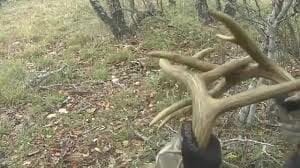 Rattling often works best as we’re getting into the actual peak of breeding. That’s when there are fewer does that are in heat than there are bucks in the area. There’s a lot of competition for those bucks to be able to get that hot doe. That’s often when rattling works the best. Oftentimes anywhere from Halloween into that first week or ten days of November. It’s typically that time period that rattling works best. You’re telling another buck, “There are two bucks over here fighting,” which suggests there’s probably a doe nearby because they’re not fighting just to fight. There’s more likely that somebody is there that’s drawing their attention. That often is the best time.
Rattling often works best as we’re getting into the actual peak of breeding. That’s when there are fewer does that are in heat than there are bucks in the area. There’s a lot of competition for those bucks to be able to get that hot doe. That’s often when rattling works the best. Oftentimes anywhere from Halloween into that first week or ten days of November. It’s typically that time period that rattling works best. You’re telling another buck, “There are two bucks over here fighting,” which suggests there’s probably a doe nearby because they’re not fighting just to fight. There’s more likely that somebody is there that’s drawing their attention. That often is the best time.
As far as grunting though, I’m a huge fan of a grunt call. I’ll never go deer hunting without a grunt call because it’s fun to communicate with deer. They may not be as exciting as rattling in the deer, but you can use it effectively over a wide range of time because you can grunt through bucks just as when it’s starting all the way up through the peak of when rattling works best. There’s a little more versatility with it. You can be a little more discreet with your location while grunting. Deer are socialized. They communicate a lot through grunt. That’s a little more versatile than antlers, although I will agree with you, it’s not nearly as exciting as rattling.
Do you have your grunt tube with you? Is it in your office?
I don’t. It’s in my pack downstairs in my plastic coat.
I didn’t think about that. Can you voice grunt the different sounds?
Absolutely, and there are grunt tubes on the market and they say, “You can adjust it so that it’s a very young buck. It’s an older buck. It’s a doe based strictly on tone.” That’s not true. I spent a lot of time in research facilities when I was in graduate school. I’ve got to hear a lot of bucks grunt. I have grunt and rattled near the woods. I joked about it, and this was years ago. An old deer was running with a young buck, and now I rattle, I could immediately hear the same grunt. It was wimpy type grunt, almost like a fawn grunt. In my mind, I’m thinking it’s this younger, these two bucks in this area. I stood up at my trees and I grabbed my bow just in case. Lo and behold, this big 140-inch, four or five-year-old deer jumps out in front of me. I joke forever about this saying, “He’s like Mike Tyson of the deer world.” He had this little wimpy voice, but he was the biggest deer in the area. There’s not a lot of credence to the tone or the sounds. It’s not like the biggest and meanest buck had the deepest grunts by that.
There are a lot of variations to what a lot of buck sounds like. It’s like with turkey calling or a duck call or waterfowl. A lot of times, the inflection and the intention that you put into the call is more important than just the sound. I can sit there and make that sounds like a grunt, but if I put a little more energy into it or exciting sound, suddenly to a deer, it sounds like there’s a little bit of livelihood to it rather than just a pre-recorded sound. I don’t get tied in too hard to what is the right sound or the right volume. Deer make all kinds of different sounds. I tend to call early a lot while we’re hunting, particularly during the rut because as these bucks are moving, they can be covering large distances.
It’s not uncommon at all for me to grunt once or twice every ten minutes during a multi-hour shift because there’s going to be a deer coming in and out of the hearing range throughout the course of that. I tell people, as long as you’re not crazy with it, you’re not going to scare deer with it. You’d be amazed by the attention that you might get. It’s a fun way to interact with deer. It’s a fun way to continue hunting and particularly for kids or new hunters, it’s a great way for them to be excited and be involved with it. I tell people, “If you’re able to grunt call, practice with it just a little bit so you feel comfortable. Once you’re out there, absolutely use it. Have a good time with it.”
The tending grunt, that’s a little bit different.
Bucks will make a lot of different grunts. The basic grunt and they will also grunt where they will almost challenge another buck. They are almost locked down to somebody else when they know another one is there. It’s a little bit of a warning like, “I’m not happy you’re here. I’m up here.” There are longer grunts. They might throw in a call to another buck as well. A lot of times what I like is at the end of the grunt. Typically, if I challenge a call to another buck that I can see at the end of it and it gets a sharp pitch at the end. Often, just put a little bit more emphasis on that grunt to another deer and sometimes that’s all that it takes to have that deer standing out to everybody and be like, “I don’t appreciate being talked to that way. I’m going to go over and check that out.” The inflection in the call or your attitude in the call in many cases is more important than the actual sound that it’s made.
The tending grunt, is that a series of grunts altogether when they found the does?
It certainly can be. That’s a lot easier to make on a call with my voice. It’s almost like you’re starting and stopping multiple grunts right in a row that are short. I had seen them do that numerous times when they have a doe nearby. There are a lot of things a deer will do to communicate back and forth either to a buck or to a doe that he sees or to other bucks that are in the area. In some cases, they’re just calling even if they don’t see anything. There’s not a specific ending grunt, challenge grunt, or regular grunt. There’s a lot of different things that they will do. I don’t know if you’re a turkey hunter. I’m guessing you are. Just like there’s a yelp, a clock, a kee-kee, a pot, calling is about a lot more than just being able to do one of those four, putting them together and talking to the animal. It’s the same thing with deer hunt.
It’s a conversation and the only way you’re going to learn the conversation is to listen to the conversation. We’re talking about deer communicating with each other. It takes a lot of time than this whole lifetime around deer. Sometimes, go and listen to deer and try things. Elks are wonderful teachers because you can hear them from miles away in the right conditions or you can’t hear them and they are two more yards away. Kip’s got a wonderful DIY Colorado bull and one of his most revered trophies. All his trophies are revered but his bull in Colorado was certainly majestic.
That’s how I learned to elk talk because Larry D. Jones and Wayne Carlton kicked off elk hunting back in the late ‘70s, early ‘80s, with turkey calls, the kee-kee run. I remember Wayne Carlton did the kee-kee run and busted right into a bugle and that was the beginning of elk calling. There were a couple of other guys that were in the mix. Calling and vocalizing with the game you’re hunting is exciting. That’s why people like turkey hunting because you’re vocalizing as you’re communicating with your turkey. If you’ve never tried to learn how to do this, there are plenty of tapes, YouTube, and instruction materials. I’m sure QDMA has instruction materials on the sounds of deer.
We used to have a great VHS tape for all of your audience on grunt, snort, and wheeze. It was all the communications sounds that deer made. It was great. It was good. A lot of those are from the University of Georgia. In addition to being helpful, it absolutely makes you a better hunter. It’s a ton of fun to understand what’s going on. If it’s just a casual hunter, he would have no idea that deer make all these sounds when they communicate anywhere near the way that they do. It’s a ton of fun for sure to understand all the different sounds that they make and the reasons for it.
I’ve heard that way too many times and start wheezing. They’re not happy.
The very first time I ever heard it, I was in graduate school at the University of New Hampshire. I was a supervisor of the Brentwood Wildlife Research facility. The oldest buck we had at the time was a three-and-a-half-year-old. He was a giant deer. He was about 300 pounds. We would cut their antlers off as soon as they shed out every fall to protect the people working there. Our vet used to always tell me that you should never go on these pastures alone. I knew all the deer. I was in control of the place. I’m like, “Yeah, yeah.” I remember it was a Friday night, he stopped and said, “Is everything good?” I’m like, “Yeah, all the deer are okay.” “I’m going home for the weekend.” I was the only graduate student there at the time. The other ones were at school or work.
I went out into that three-acre pasture to take a couple of pictures and I saw this buck. It’s a three-year-old buck called Chesna, walking toward me. I said, “Chesna, how are you doing?” I took a picture of him and he’s still walking. I remember this back when you had a casual camera for filming. I saw him charge and it hit me like, “This is not good.” Long story short, I was close enough to a tree. I was able to get up into a tree. He kept me up this tree. Luckily, there was a branch that I can jump and grab that I can stand on. He kept me up there for over an hour. He would circle the tree and charge the tree. All of the bark fell off the tree. He’s keeping me up there. He snorts and wheezes 50 times. I had never heard that in my life, partly because I grew up in Pennsylvania. We didn’t get older bucks. They didn’t do that. I remember when he finally left and I got down. I ran into the gate to get out.
I called my adviser and let him know what had happened. During the course of our conversation, I was telling him about this crazy noise he was making. I remember I said, “It’s like that snort wheeze that some people in Texas talk about.” Years later, I learned about this and I start seeing some older deer and realized, “That was a grunt, snort and wheeze.” The first time I’ve ever heard of this would’ve been like in maybe 1994. Look how far it has come now. Many hunters have experience in the woods because we have better age structures of the deer. I’ve watched deer do that. I have used that to call deer in. It’s a great sound. If you’re in the woods, you know you’re in a good spot if you hear that. The first time I ever heard it, I was not in a good spot.
This whole show is about hunting whitetails. We’re sharing, learning about the whitetail and everything about them. Their mannerisms and they’re highly social. They also talk. It’s up to us to learn what all that means. The better you do that and the people that are figuring it out become better hunters. Is their experience any better than sitting on a stump and wait for deer to come by? Probably not because that’s your hunt and that’s a nice thing. You can move forward and all of a sudden, you realized when a buck bristles up and gets all angry, it’s neat to see. It’s neat to be there.
They all have their own personalities. Older bucks are shy, some are aggressive, and some younger bucks are more aggressive. Each has his own personality and the same with the does. We can tell the bucks far better with their antlers. Even older deer, you can hunt them differently, whether they tend to be movers and shakers or shy and secretive. Scouting and game cameras certainly help. All of those can help you put the pieces together to help you get within bow range of one of those deer.
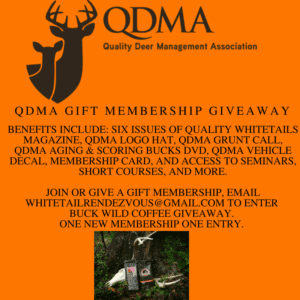 What do you know now that you wish you knew ten years ago when it comes to hunting deer?
What do you know now that you wish you knew ten years ago when it comes to hunting deer?
We know so much more about how deer move and how they react to pressure. Back in the day, I would go hunting every single chance I had. I never ever pay attention to which way the wind was blowing before or after or even during the hunt and just go out. I’m sure I scared many deer before I ever saw them. It’s negatively impacted my future hunts. If I knew one thing now that I could take and go back, pay attention to the wind when you go so that you’re not scaring all these deer that you would never get an opportunity to see. It’s the simplest form. Some people get heavy into all the scent control stuff.
Wherever you are on that gradient, whether you walk and pay attention a little bit, being ultra-observer, a bunch of scent control. The very least, pay attention to the wind blowing in your face. Think where the deer are going to come from, they were upwind from you, and you will be so much more successful. I can’t even imagine how many deer I stoked in the past because I didn’t pay any attention at all to that. That’s easy to do. It doesn’t cost you any money. By being a little bit smarter, you can be way more effective seeing and shooting deer. That’s my tip. I would’ve seen a lot more deer in my career if I have known that many years ago.
How would somebody become a member of QDMA?
They can go right to our website, which is QDMA.com and join. They can call our national office at 1-800-209-DEER. You’d be amazed where deer hunters belong. We fight for deer herds so if you’re a hunter, we’ll have a long opportunity to hunt in the future. If you’re a deer hunter, you belong with us. The very least, you can come to check out all the educational resources that we have on our website to help make you a better deer hunter and increase your chances of crossing paths with that deer of your dreams this fall. Good luck and try to be safe in the woods. Good luck to all your audience as well. I’ve been a wildlife biologist for many years, but I’m first and foremost a deer hunter. I mainly excited as you are, Bruce, and this is certainly a great time of the year.
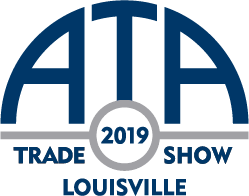 Kip Adams, once again, thank you so much for being our guest on Whitetail Rendezvous. I look forward to seeing you at ATA in a few months. Thank you for everything that QDMA does because they are the leader in a whitetail science, whitetail research, and communicating about whitetails. What you do throughout the country is very admirable. Thank you for being our guest here.
Kip Adams, once again, thank you so much for being our guest on Whitetail Rendezvous. I look forward to seeing you at ATA in a few months. Thank you for everything that QDMA does because they are the leader in a whitetail science, whitetail research, and communicating about whitetails. What you do throughout the country is very admirable. Thank you for being our guest here.
Absolutely, Bruce, anytime and good luck to you in the woods.
important Links:
About Kip Adams
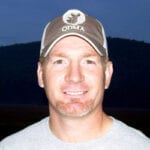 Kip Adams of Knoxville, Pennsylvania, is a certified wildlife biologist and QDMA’s Director of Conservation. He has a bachelor’s degree in wildlife and fisheries science from Penn State University and a master’s in wildlife from the University of New Hampshire. He’s also a certified taxidermist. Before joining QDMA, Kip was the deer and bear biologist for the New Hampshire Fish & Game Department. Kip and his wife Amy have a daughter, Katie, and a son, Bo.
Kip Adams of Knoxville, Pennsylvania, is a certified wildlife biologist and QDMA’s Director of Conservation. He has a bachelor’s degree in wildlife and fisheries science from Penn State University and a master’s in wildlife from the University of New Hampshire. He’s also a certified taxidermist. Before joining QDMA, Kip was the deer and bear biologist for the New Hampshire Fish & Game Department. Kip and his wife Amy have a daughter, Katie, and a son, Bo.
